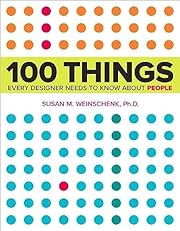

Cliquer sur une vignette pour aller sur Google Books.
|
Chargement... 100 Things Every Designer Needs to Know About People: What Makes Them Tick? (Voices That Matter) by Weinschenk, Susan 1 edition (2011)par Susan Weinschenk
 Aucun Actuellement, il n'y a pas de discussions au sujet de ce livre.   ) )aucune critique | ajouter une critique
Appartient à la série
WE DESIGN TO ELICIT RESPONSES from people. We want them to buy something, read more, or take action of some kind. Designing without understanding what makes people act the way they do is like exploring a new city without a map: results will be haphazard, confusing, and inefficient. This book combines real science and research with practical examples to deliver a guide every designer needs. With this book you'll design more intuitive and engaging apps, software, websites and products that match the way people think, decide and behave. INCREASE THE EFFECTIVENESS OF YOUR PRODUCTS. Apply psychology and behavioral science to your designs. Here are some of the questions this book will answer: * What grabs and holds attention. * What makes memories stick? * What is more important, peripheral or central vision? * Can you predict the types of errors people will make? * What is the limit to someone's social circle? * What line length for text is best? * Are some fonts better than others? These are just a few of the questions that the book answers in its deep-dive exploration of what makes people tick. Aucune description trouvée dans une bibliothèque |
Discussion en coursAucunCouvertures populaires
 Google Books — Chargement... Google Books — Chargement...GenresClassification décimale de Melvil (CDD)745.4The arts Graphic arts and decorative arts Decorative Arts Pure And AppliedClassification de la Bibliothèque du CongrèsÉvaluationMoyenne: (4.01) (4.01)
Est-ce vous ?Devenez un(e) auteur LibraryThing. |
||||||||||||||||||||||||||||||||||||||||||||||||||||||||||||||||||||||||||||||||||||||||||||||||||||||||||||||||||||||||